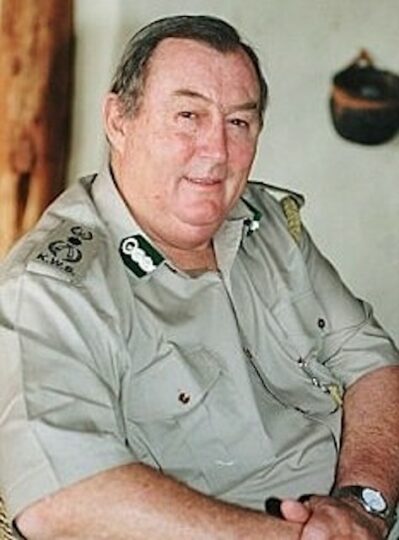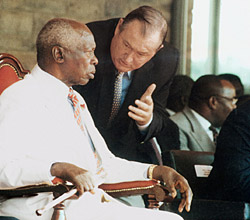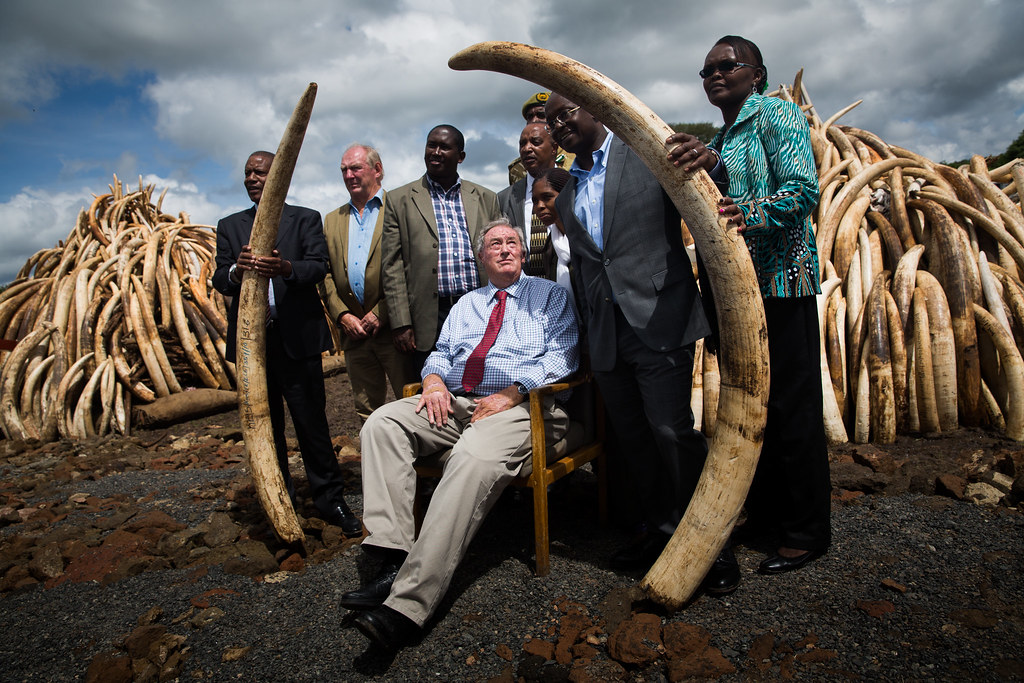Richard Leakey, a world-famous Kenyan conservationist, and fossil hunter, passed away at the age of 77.
His breakthrough work aided in the acknowledgment of Africa as the cradle of civilization.
He also led anti-poaching initiatives in Kenya, including the famous burning of the country’s stockpile of poached ivory.
Uhuru Kenyatta, Kenya’s president, said Leakey “served our country with distinction.”
 Leakey worked for the Kenyan government in a variety of capacities, including the National Museums of Kenya, the Kenya Wildlife Service, and as the civil service’s chief.
Leakey worked for the Kenyan government in a variety of capacities, including the National Museums of Kenya, the Kenya Wildlife Service, and as the civil service’s chief.
“Dr Leakey is known for his significant involvement in Kenya’s civil society, where he built and effectively led a number of organizations,” Mr Kenyatta added, in addition to his outstanding career in public service.
In his twenties, Leakey made his own significant discoveries, and he described the emergence of Homo erectus, an ancestor of modern humans, in two groundbreaking books (Origins and People of the Lake).
His findings added to the increasing body of evidence indicating the continent of Africa was home to the first humans.
In 1981, he starred in “The Making of Mankind,” a seven-part BBC television series that made him a household figure.
He changed occupations in the late 1980s to become the head of Kenya’s Wildlife Service, at a time when poachers were annihilating the country’s elephant and rhino herds.
He ordered his rangers to shoot poachers on sight, and he orchestrated a dramatic public burning of a massive collection of ivory.
The little plane he was piloting lost power and crashed in 1993. He lived, but both of his legs below the knee were amputated.
Richard Leakey & Kenyan Politics
 That didn’t stop him from joining Kenyan politics and founding the Safina party. But his political career was short-lived, and in 1998 he was appointed head of Kenya’s civil service, with the objective of combating official corruption.
That didn’t stop him from joining Kenyan politics and founding the Safina party. But his political career was short-lived, and in 1998 he was appointed head of Kenya’s civil service, with the objective of combating official corruption.
He stayed in the position for three years before returning to the Kenya Wildlife Service.
He was the chairman of the Turkana Basin Institute at Stony Brook University in the United States when he died. The institution promotes palaeontology and archaeology research and teaching in northern Kenya.
Leakey, according to Kenya’s Deputy President William Ruto, “His devotion to his homeland inspired many Kenyans. He adored the country of Kenya “..
The Duke of Cambridge expressed his gratitude for the opportunity to meet him and applauded his efforts to combat elephant poaching. In a tweet, Prince William remarked, “Conservation has lost a real visionary.”
Richard Leakey was a strongly autonomous thinker from an early age. His parents’ well-known archaeology work undoubtedly influenced his career choice.
Even though he was only in his early twenties, he established his own voice and made important discoveries.
He was a fighter as well. He cracked his head as a youngster after falling from a horse. He endured kidney and liver transplants later in life, as well as battling cancer and surviving an aircraft catastrophe in which he lost both legs. But he didn’t lose sight of his goals.
Kenyan politics, on the other hand, proved difficult. Leakey was a vocal opponent of Daniel Arap Moi’s administration. He even started his own political party to fight it.
He accepted, though, when Moi urged him to command the public service and battle corruption. Foreign financing that had been halted owing to corruption began to flow once more. However, he was abruptly cut off. Leakey quit after being outmaneuvered.
But he leaves an indelible influence on science and conservation.
In paleoanthropology, Leakey followed in his parents’ footsteps, examining fossils and old artifacts to better understand human evolution.
The First Family of Paleontology
 Because much of their life, and subsequently the lives of their children, centred around Olduvai Gorge, Louis and Mary (Nicol) Leakey are frequently referred to as the “first family of paleontology.” The pair met on a dig in England, and both worked at the Olduvai Gorge for a short time before marrying in 1937 in England.
Because much of their life, and subsequently the lives of their children, centred around Olduvai Gorge, Louis and Mary (Nicol) Leakey are frequently referred to as the “first family of paleontology.” The pair met on a dig in England, and both worked at the Olduvai Gorge for a short time before marrying in 1937 in England.
Louis was born in Kenya in 1903 to missionary parents from England. While out bird watching, he would frequently come across prehistoric stone implements. He undertook a fossil-finding trip to what is now Tanzania after graduating from university in England, which ignited his interest in human origins.
The Leakeys discovered stone tools in Olduvai and elsewhere in the 1930s. Several ancient species, notably the 25-million-year-old Pronconsul primate, one of the earliest and rare fossil ape skulls found, were among their most famous discovery.
They had to put their work on hold due to political upheaval in Kenya, but they returned to Olduvai Gorge in the late 1950s. While their prior investigation at the gorge had centered on tools, they returned to seek for further traces of human existence.
Mary went to work as normal one day in 1959, leaving Louis behind with a headache. She uncovered fossilized portions of a hominin’s cranium and upper teeth that had never been recognized before.
The Leakeys discovered roughly 400 parts of a virtually complete skull over the next few weeks. Other findings, such as those made in South Africa by Raymond Dart in 1924 and Robert Broom in 1936, have parallels. The Leakeys, on the other hand, categorized their discovery as a new species of hominid, naming it Zinjanthropus boisei.
Although it was not the direct ancestor of humanity that the Leakeys had hoped for, it did provide the couple some prominence and sparked public interest in human origins research.
They estimated the find to be 1.75 million years old. Although a lack of fossil-dating equipment made determining the age of Dart’s and Broom’s previous discovery problematic, this made it the oldest hominin known to that moment.
The work of the Leakeys, Dart, and Broom combined to provide a compelling argument that humans originated in Africa.
Louis Leakey became ill in 1960, and Mary took over the majority of the enterprise. Several things happened during this time period. They found a well-preserved fossil foot with arches, supporting the notion that hominins walked erect.
During this period, Mary Leakey and her son Jonathan discovered a smaller hominid they named Homo habilis, which means “handy human” since he appeared to be able to use tools. The age of this fossil is estimated to be around 2 million years old. When another son, Richard, discovered another Homo habilis in 1972, this was verified.
This finding in 1972 backed up the older Leakey’s claim that numerous hominid lineages evolved at the same time and that the Homo genus did not arise from Australopithecus.
Twiggy
In 1968, Peter Nzube, a member of the Leakey team, unearthed a 1.8-million-year-old skull. The skull was flattened and had to be rebuilt from hundreds of bits, earning it the nickname Twiggy after the slender British model. Twiggy was thought to have been an adult when she died since her third set of teeth had erupted. The molars, on the other hand, showed little damage, indicating that she had plenty of opportunity to use them.
However, the Leakeys were not responsible for the most important and noteworthy discoveries in Olduvai Gorge, according to some experts. A team of Tanzanian and American archeologists discovered 302 bones and teeth belonging to a female estimated to be 1.8 million years old in 1986.